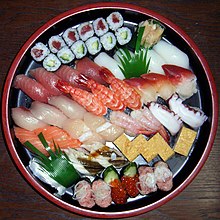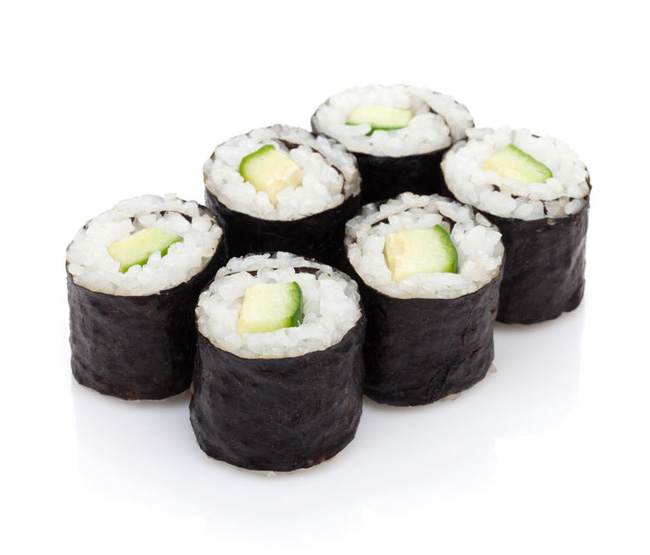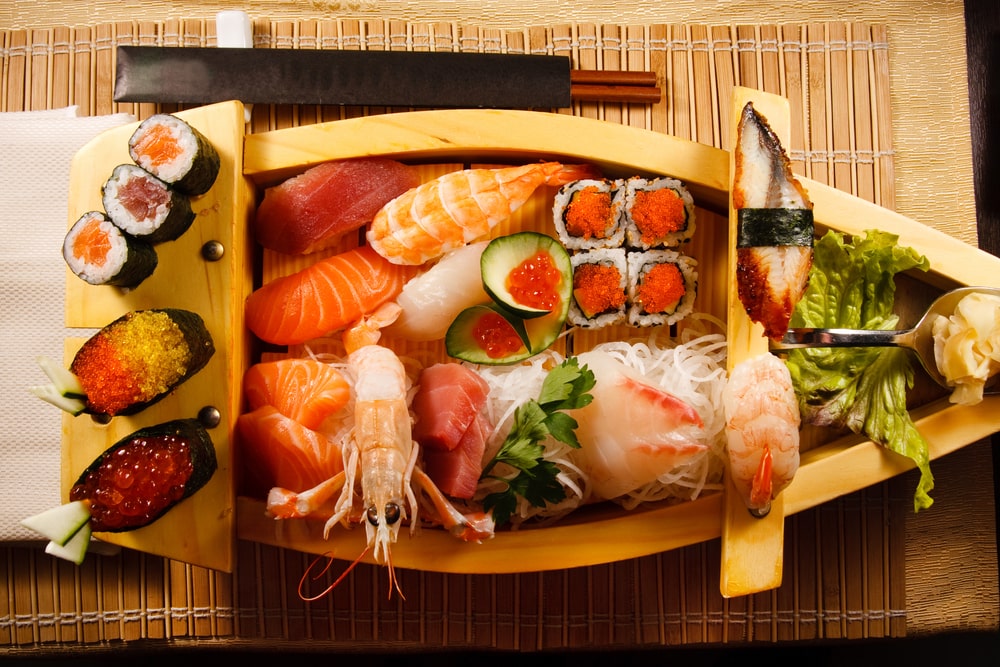
Introduction
Sushi is a popular Japanese dish that has gained worldwide popularity. It is often perceived as a healthy option because it includes raw fish and vegetables. However, there is a common misconception that sushi is only made with seafood. In this article, we will explore whether sushi is exclusively a seafood dish or if it can be made with other ingredients as well.
What Is Sushi?
Sushi is a dish that consists of vinegared rice combined with various ingredients such as seafood, vegetables, and condiments. The rice used in sushi is seasoned with vinegar, salt, and sugar, giving it a unique flavor. The most common type of sushi is made with raw fish, known as sashimi, which is placed on top of a small mound of rice. However, sushi can also be made with cooked fish, shellfish, or even vegetarian ingredients like tofu or avocado.
Common Misconception About Sushi And Seafood
One of the most common misconceptions about sushi is that it is exclusively made with seafood. While raw fish is a popular ingredient in many types of sushi, not all sushi contains seafood. In fact, there are many vegetarian options available, such as cucumber rolls or avocado rolls, which do not include any seafood. Sushi is a versatile dish that can be customized to suit individual tastes and preferences.
Despite the misconception, it is important to note that seafood is a significant component of sushi. The freshness and quality of the seafood used in sushi are crucial to its taste and overall dining experience. Many sushi lovers enjoy the delicate flavors and textures that seafood brings to the dish.
In conclusion, sushi is not exclusively a seafood dish. While raw fish is a common ingredient, there are many variations and options available that do not include seafood. Sushi can be customized to suit different dietary preferences and can encompass a wide range of flavors and ingredients. So, the next time you visit a sushi restaurant, don’t be afraid to explore and try different types of sushi beyond just seafood.
Vinegared Rice: The Foundation Of Sushi
The key ingredient in sushi is the vinegared rice. It is made by combining cooked rice with a mixture of rice vinegar, sugar, and salt. This mixture gives the rice its distinctive tangy flavor and helps to preserve it. The rice used for sushi should be short-grain and sticky, which allows it to hold its shape when rolled or molded into sushi.
Other Ingredients Besides Seafood In Sushi
While seafood is commonly associated with sushi, there are many other ingredients that can be used to create delicious sushi rolls. Some popular non-seafood options include:
- Tofu: Marinated or cooked tofu can be used as a protein-rich filling for sushi rolls.
- Avocado: Creamy and nutritious, avocado is often used in vegetarian sushi rolls.
- Cucumber: Refreshing and crisp, cucumber adds a crunchy texture to sushi rolls.
- Carrots: Thinly sliced or grated carrots can add a pop of color and crunch to sushi rolls.
- Mushrooms: Cooked mushrooms, such as shiitake or enoki, can provide a savory and earthy flavor to sushi rolls.
These are just a few examples of the variety of ingredients that can be used in sushi. The choice of ingredients depends on personal preferences and dietary restrictions. Sushi is a versatile dish that can be customized to suit different tastes and preferences.
Seafood In Sushi
Various Types Of Seafood Used In Sushi
Sushi is known for its wide variety of seafood ingredients. From tuna to shrimp to sea urchin, there are numerous options to choose from when it comes to creating delicious sushi rolls. Some of the common types of seafood used in sushi include:
- Pacific bluefin tuna: also known as otoro and negitoro
- Atlantic salmon: called sāmon and harasu
- Salmon roe: known as ikura
- Black tiger prawn: referred to as ebi
- Cuttlefish: referred to as mongo-ika
- Yellowtail: known as hamachi, kampachi, hiramasa, tsubasu, and buri
- Sea urchin: also known as uni
- Yesso Scallop: called hotate
- Conger eel: known as anago
- Olive flounder: referred to as engawa
- Sweet shrimp: known as ama-ebi
Popular Seafood Options For Sushi
While the list above provides a comprehensive range of seafood options, there are some popular choices that many sushi enthusiasts enjoy. These include:
- Salmon: Atlantic salmon is a versatile fish that can be served raw or cooked.
- Tuna: Pacific bluefin tuna, especially the fatty cuts like otoro and negitoro, are highly prized in sushi.
- Shrimp: Black tiger prawns, also called ebi, are often used in sushi rolls.
- Sea urchin: Uni has a rich and creamy texture that adds a unique flavor to sushi.
- Scallop: Yesso scallops, known as hotate, are popular for their sweet and delicate taste.
These are just a few examples of the wide range of seafood options that can be incorporated into sushi. The choice of ingredients ultimately depends on personal preferences and availability. Sushi is a versatile dish that allows for endless combinations of seafood and other ingredients.

Non-seafood Options In Sushi
Vegetarian Sushi Options
Contrary to popular belief, sushi can be enjoyed by vegetarians too. In fact, there are numerous creative and delicious vegetarian options available. Here are some common non-seafood ingredients used in vegetarian sushi:
- Cucumber: Thin slices of fresh cucumber add a refreshing crunch to sushi rolls.
- Avocado: The creamy texture of avocado pairs well with the vinegared rice.
- Tofu: Grilled or marinated tofu can be used as a protein-rich substitute in sushi.
- Egg omelette: Known as tamago, the sweet and savory egg omelette is a popular ingredient in sushi.
- Shiitake mushroom: These flavorful mushrooms can be sautéed or marinated to add an umami taste to sushi.
Fruit-based Sushi Variations
For those looking for a unique twist on traditional sushi, fruit-based variations can be a delightful option. These sushi rolls incorporate fruits like mango, pineapple, and strawberry to create a sweet and tangy flavor profile. The fruit is often paired with cream cheese or avocado to balance the sweetness. Fruit-based sushi variations are a great choice for those with a sweet tooth or for a refreshing dessert option.
It’s important to note that while these non-seafood options are available, they are typically separate from the seafood options in traditional sushi restaurants. Some sushi restaurants may offer vegetarian or fruit-based sushi rolls, but it’s always a good idea to check with the establishment beforehand.
Whether you prefer the classic seafood options or opt for the non-seafood alternatives, sushi offers a wide range of flavors and textures to satisfy any palate. So the next time you dine at a sushi restaurant, don’t hesitate to explore the diverse world of sushi beyond the traditional seafood dishes.
Health Considerations
Sushi As A Healthy Option
Sushi is often considered a healthy option due to its use of fresh ingredients like fish, vegetables, and seaweed. These components offer various health benefits, such as:
- Omega-3 fatty acids: Fish used in sushi, such as salmon and tuna, are rich in omega-3 fatty acids. These healthy fats have been shown to promote heart and brain health.
- Lean protein: The seafood in sushi provides a good source of lean protein, which is essential for muscle growth and repair.
- Minerals and vitamins: Sushi contains several essential minerals and vitamins, including iodine from seaweed and B vitamins from fish.
- Fiber: Sushi rolls that include vegetables or brown rice provide dietary fiber, which aids in digestion and helps maintain a healthy weight.
Mercury Levels In Seafood And Its Impact
While sushi offers many health benefits, it’s important to be mindful of the mercury levels in certain types of seafood. Some larger fish, like tuna and swordfish, can contain higher levels of mercury due to biomagnification in the food chain. Mercury can be harmful, especially to pregnant women, nursing mothers, and young children.
To minimize exposure to mercury, consider the following:
- Choose smaller fish: Smaller fish, such as sardines and mackerel, tend to have lower mercury levels.
- Vary your choices: By consuming a variety of seafood, you can reduce the overall mercury exposure and enjoy the health benefits of different types of fish.
- Limit intake for sensitive groups: Pregnant women, nursing mothers, and young children may want to limit their consumption of high-mercury fish.
It’s also important to note that sushi made with raw fish carries a small risk of foodborne illnesses. To reduce this risk, ensure that the sushi restaurant follows proper food safety practices and that the fish used is sourced from reputable suppliers.
In summary, sushi can be a healthy option, providing a range of nutrients and healthy fats. However, it’s essential to consider mercury levels in certain seafood and take precautions, especially for sensitive groups. By making informed choices and enjoying a varied selection of sushi, you can indulge in this delicious and nutritious cuisine.
Sustainability Of Seafood In Sushi
Sustainable Sourcing Practices In The Seafood Industry
Sustainable sushi suppliers and restaurants prioritize seafood sourced from sustainable fisheries or aquaculture. To ensure responsible sourcing, they often work with organizations such as the Marine Stewardship Council or the Aquaculture Stewardship Council. Species selection is a crucial factor in sustainable sushi, emphasizing the use of seafood species that are abundant, resilient, and resistant to overfishing or extinction. These practices contribute to the preservation of marine ecosystems and the long-term viability of seafood resources.
Importance Of Choosing Sustainable Seafood For Sushi
The transformation of sushi to prioritize sustainable seafood is driven by growing concerns over the environmental impact and overfishing of seafood. Embracing the concept of seasonality, sustainable sushi restaurants use seafood in season and when it is abundant. This not only reduces pressure on vulnerable species but also ensures the freshest and highest quality ingredients for sushi lovers.
Health Considerations
Sushi As A Healthy Option
Sushi is often considered a healthy option due to its use of fresh ingredients like fish, vegetables, and seaweed. These components offer various health benefits, such as:- Omega-3 fatty acids: Fish used in sushi, such as salmon and tuna, are rich in omega-3 fatty acids that promote heart and brain health.- Lean protein: The seafood in sushi provides a good source of lean protein, essential for muscle growth and repair.- Minerals and vitamins: Sushi contains several essential minerals and vitamins, including iodine from seaweed and B vitamins from fish.- Fiber: Sushi rolls that include vegetables or brown rice provide dietary fiber, aiding digestion and maintaining a healthy weight.
Mercury Levels In Seafood And Its Impact
While sushi offers many health benefits, it’s important to be mindful of mercury levels in certain types of seafood. Some larger fish, like tuna and swordfish, can contain higher levels of mercury due to biomagnification in the food chain. This could be harmful, especially to pregnant women, nursing mothers, and young children. To minimize exposure to mercury, it is recommended to choose smaller fish with lower mercury levels, vary seafood choices to reduce overall exposure, and limit intake of high-mercury fish for sensitive groups.
It’s also essential to note that sushi made with raw fish carries a small risk of foodborne illnesses. To reduce this risk, ensure that the sushi restaurant follows proper food safety practices and sources fish from reputable suppliers. By making informed choices and enjoying a varied selection of sushi, individuals can indulge in this delicious and nutritious cuisine while considering sustainability and health factors.

The Evolution Of Sushi
Historical Origins Of Sushi
Sushi originated in Japan and has a rich cultural history. It began as a humble street food enjoyed by laborers and travelers. In its early days, sushi was made by fermenting fish with rice, which allowed it to be preserved for longer periods. The fermentation process was eventually replaced with the use of vinegar, giving rise to the sushi we know today.
How Sushi Has Adapted To Different Cultures And Preferences
Sushi has evolved significantly over time, particularly as it gained popularity beyond Japan. It has been adapted and modified to cater to different cultures and preferences. Western countries, for example, introduced ingredients like avocado and cream cheese to create unique sushi rolls. This fusion of flavors and ingredients has expanded the range of options available to sushi lovers worldwide.
The Future Of Sushi And Its Evolving Global Influence
Sushi has not only become a global cuisine but continues to inspire new generations of chefs and food lovers. The sustainability of seafood in sushi has become a significant concern, leading to the adoption of sustainable sourcing practices. This involves working with organizations like the Marine Stewardship Council and the Aquaculture Stewardship Council to ensure responsible sourcing.
Choosing sustainable seafood for sushi is crucial for preserving marine ecosystems and ensuring the long-term viability of seafood resources. Sustainable sushi restaurants prioritize species that are abundant, resilient, and resistant to overfishing or extinction. They also embrace the concept of seasonality, using seafood when it is in season and abundant.
Sushi is often considered a healthy option due to its use of fresh ingredients. It provides various health benefits, including omega-3 fatty acids, lean protein, essential minerals and vitamins, and dietary fiber. However, it’s important to be mindful of mercury levels in certain types of seafood, especially for sensitive groups like pregnant women and young children.
By making informed choices and considering sustainability and health factors, individuals can continue to enjoy the evolving world of sushi. Its adaptability and global influence ensure that it will remain a beloved dish for generations to come.
Popular Sushi Varieties
Nigiri Sushi: The Classic Sushi Style
Nigiri sushi is a beloved and well-known sushi style that originated in Japan. It consists of a simple but delicious combination of raw fish and a small, hand-formed ball of sushi rice. This style of sushi emphasizes the natural flavors of the fish, allowing the quality and freshness to shine.
Maki Sushi: Sushi Rolls With Various Fillings
Maki sushi, also known as makizushi, is a type of sushi that is made by wrapping sushi rice and a filling in a sheet of nori seaweed. There are several types of maki sushi, each differing in the folding technique and size. It is a popular option for those who prefer a more diverse range of flavors and textures in their sushi.
Maki sushi offers endless possibilities for fillings, including seafood, vegetables, and even combinations of both. From traditional favorites like tuna and salmon rolls to creative variations like avocado and cream cheese rolls, there is something for everyone’s taste.
One popular type of maki sushi is temaki, which translates to “hand roll.” It is made by wrapping a large seaweed cone around rice, fish, and other sushi fillings. Temaki is a fun and interactive option that can be enjoyed as a handheld snack or meal.
Whether you prefer the simplicity of nigiri sushi or the variety of maki sushi, Japanese cuisine offers a wide array of sushi options to suit every palate. The artistry and attention to detail in the preparation of sushi, combined with the freshness of the ingredients, make it an exquisite dining experience that continues to captivate food lovers around the world.
Popular Sushi Varieties
Nigiri Sushi: The Classic Sushi Style
Nigiri sushi is a beloved and well-known sushi style that originated in Japan. It consists of a simple but delicious combination of raw fish and a small, hand-formed ball of sushi rice. This style of sushi emphasizes the natural flavors of the fish, allowing the quality and freshness to shine.
Maki Sushi: Sushi Rolls With Various Fillings
Maki sushi, also known as makizushi, is a type of sushi that is made by wrapping sushi rice and a filling in a sheet of nori seaweed. There are several types of maki sushi, each differing in the folding technique and size. It is a popular option for those who prefer a more diverse range of flavors and textures in their sushi.
- Maki sushi offers endless possibilities for fillings, including seafood, vegetables, and even combinations of both.
- Traditional favorites like tuna and salmon rolls offer a classic sushi experience.
- Creative variations like avocado and cream cheese rolls provide unique and tasty flavor combinations.
- Temaki, or hand rolls, are a fun and interactive option that can be enjoyed as a handheld snack or meal.
Exploring The Wide Range Of Sushi Options Beyond Seafood
Sushi may be commonly associated with seafood, but there are many options available for those who do not prefer seafood or are vegetarian.
- Vegetable rolls: These sushi rolls are made with a variety of fresh vegetables like cucumber, avocado, and carrots. They offer a refreshing and crunchy texture.
- Tempura rolls: Tempura is a Japanese cooking technique where ingredients are battered and deep-fried. Tempura rolls include vegetable tempura, providing a crispy and flavorful element to the sushi roll.
- Tofu rolls: Tofu, a popular protein source for vegetarians, can be sliced, marinated, and used as a filling in sushi rolls. It adds a creamy and delicate flavor.
- Fruit rolls: For those who enjoy a touch of sweetness in their sushi, fruit rolls are a great choice. Fruits like mango and strawberry can be paired with sushi rice for a unique and refreshing taste.
Conclusion
In conclusion, sushi is a versatile dish that offers a wide variety of flavors and textures. Whether you prefer nigiri, maki, or non-seafood alternatives, there is a type of sushi that will suit your taste buds. The artistry and attention to detail in the preparation of sushi, combined with the freshness of the ingredients, make it an exquisite dining experience that continues to captivate food lovers around the world.
Summary Of Key Takeaways
- Nigiri sushi is a classic sushi style that highlights the natural flavors of raw fish.
- Maki sushi provides a diverse range of flavors and textures with its various fillings and folding techniques.
- Sushi options extend beyond seafood to include vegetarian and fruit-based rolls.
- The freshness and artistry of sushi preparation make it a beloved and enticing culinary experience.
FAQ: Is Sushi Seafood? Sourcing the Sea in Sushi
Q: Is sushi considered seafood?
A: Yes, sushi is often associated with seafood. It typically consists of vinegared rice combined with various ingredients such as raw or cooked seafood, vegetables, and occasionally tropical fruits.
Q: Is sushi exclusively made with seafood?
A: While seafood is a common component of sushi, it is not the sole requirement. Sushi can also be made using vegetarian or cooked ingredients, allowing for a diverse range of options to cater to different dietary preferences.
Q: What types of seafood are commonly used in sushi?
A: Sushi can feature an assortment of seafood including tuna, salmon, shrimp, eel, crab, scallops, octopus, and yellowtail. These options can vary depending on regional availability and personal taste.
Q: Can sushi be made with fish other than seafood?
A: Yes, various freshwater fish like trout or carp can also be used in sushi preparation. However, it’s important to note that sushi has traditionally been associated with sea-dwelling creatures.
Q: Are all sushi seafood rolls raw?
A: Not all sushi rolls feature raw seafood. Cooked or smoked fish like shrimp tempura, cooked crab, or smoked salmon are also popular ingredients in sushi rolls. Vegetarian options like cucumber, avocado, and tofu can be included for those who prefer non-seafood options.
Q: How is the quality of seafood ensured in sushi?
A: Establishments that specialize in sushi are typically committed to sourcing high-quality seafood. This includes working closely with trusted suppliers and adhering to strict standards of freshness and safety. The freshness and quality are crucial aspects of a delectable sushi experience.
Q: Is it safe to eat raw seafood in sushi?
A: When handled and prepared correctly, raw seafood used in sushi is generally safe to consume. Sushi chefs are trained to source and handle seafood with care to minimize any risks. However, it’s essential to choose reputable restaurants or sushi bars where hygiene practices are prioritized.
Q: Can sushi be enjoyed by those with seafood allergies or dietary restrictions?
A: Yes, individuals with seafood allergies or dietary restrictions can still enjoy sushi. Many sushi restaurants offer vegetarian rolls or options that incorporate cooked proteins like chicken, beef, or tofu. It’s advisable to inform the chef or server about any allergies or dietary restrictions to ensure a safe and enjoyable dining experience.
Q: Do all sushi rolls contain seafood?
A: No, sushi rolls can come in various forms, and not all of them contain seafood. Vegetarian sushi rolls or options with cooked proteins are widely available to cater to different preferences and dietary needs.
Q: How should sushi enthusiasts approach sustainable sourcing of seafood?
A: Sustainable sourcing is a significant concern when it comes to seafood consumption. Sushi enthusiasts can make informed choices by selecting restaurants that prioritize sustainability and choose seafood from responsible sources. Look for indications of sustainability certification or ask the staff about their sourcing practices to support eco-friendly initiatives.
Q: Can sushi be enjoyed by those who do not like seafood?
A: Absolutely! Sushi offers an array of options beyond seafood. Vegetarian rolls with ingredients like cucumber, avocado, sweet potato, or pickled vegetables can be equally delicious. Cooked sushi rolls with ingredients like tempura or tofu are also available for those who prefer non-seafood options.
In summary, while sushi is commonly associated with seafood, it offers a wide range of options to cater to different tastes and dietary preferences. Whether you love seafood or prefer vegetarian or cooked options, there is a sushi choice for everyone!

Our restaurant focuses on providing fresh, new, and cultural dishes to satisfy our customers! All of our dishes are made with the freshest ingredients and with the highest quality spices. We mainly focus on our presentation as well as our flavors. Our main ingredients are fresh meat, seafood, fruits, and vegetables. Some of our Chinese dishes are more raw and pure, while others are sour and spicy. It all depends on what you enjoy; we have it all.
